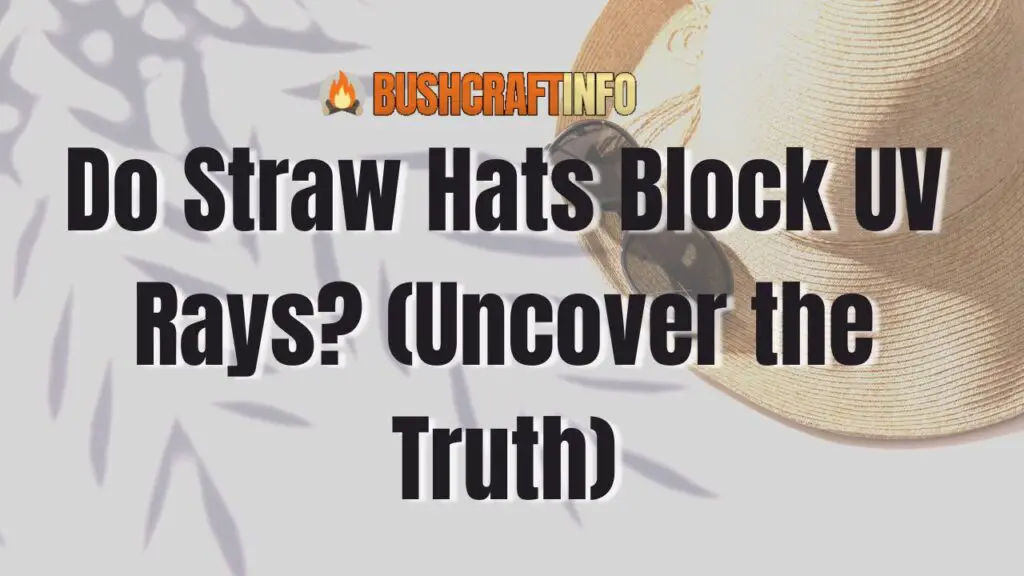You might have seen a lot of people wearing straw hats when going outdoors. The question is: Do straw hats block UV rays?
Yes, straw hats can block UV rays by providing up to 50+ UV protection. This is because straw hats are made of tightly-woven material. The more tight the weave, the better the protection.
The average straw hat has a UPF (Ultraviolet Protection Factor) of about 6, which means it will block out about 94% of the UV radiation. So if you are wearing a straw hat, you are still getting some protection from the sun.
Let’s take a look at some other factors and understand how straw hats can block UV rays. Additionally, up to which extent can these hats provide protection against such harmful radiations.

Can UV Go Through a Straw Hat?
The answer is no. Ultraviolet rays cannot go through a straw hat. In fact, any type of fabric can block UV rays, including straw hats.
The level of protection that a straw hat provides depends on its weave. A tighter weave will provide more protection than a looser one. For example, a Panama hat has a very tight weave and can provide up to 50+ UPF.
What Type of Hat is Best for Sun Protection?
There is no one-size-fits-all answer to this question. The type of hat that is best for sun protection depends on your personal needs and preferences.
If you are looking for a straw hat that can provide the most sun protection, look for one with a UPF rating of 50+ and a brim that is at least 3 inches wide.
Panama hats and sun hats are two types of straw hats that meet these criteria.
On the other hand, if you are looking for a straw hat that is more stylish than functional, you can choose one with a UPF rating of 30 or less. Keep in mind that straw hats with lower UPF ratings will provide less sun protection.
Some straw hats, like the ones made from raffia, do not have a UPF rating. In general, these types of straw hats provide less sun protection than other straw hats.
When shopping for a straw hat, always check the label to see the UPF rating. This will give you an idea of how much protection the hat can provide.
What is UPF Rating?
The UPF rating is a measure of the amount of UV radiation that can pass through a fabric. The higher the UPF rating, the less UV radiation will pass through the fabric.
UPF ratings range from 15 to 50+. A UPF 50+ rating means that less than 2% of the UV radiation will pass through the fabric.
Most straw hats have a UPF rating of 30 or less. Some straw hats, like Panama hats, have a UPF rating of 50+.
What Color Blocks the Most UV Rays?
Darker colors generally provide more UV protection than lighter colors. This is because darker colors absorb more UV radiation than lighter colors. For example, a black shirt has a UPF of about 13, while a white shirt has a UPF of about 7.
While dark colors provide more UV protection, they can also make you feel hotter in the sun. If you are looking for a straw hat that will keep you cool in the sun, choose a light-colored one.
Are Straw Hats Breathable?
Straw hats are generally breathable, but this depends on the type of straw and the weave. For example, Panama hats made from toquilla straw are very breathable. On the other hand, straw hats made from raffia are not as breathable.
When shopping for a straw hat, always check the label to see if the hat is breathable. This will give you an idea of how comfortable the hat will be to wear in hot weather.
How Long Can You Wear a Straw Hat?
You can wear a straw hat for as long as you want. There is no time limit. However, it is important to note that straw hats are not waterproof. So if you are caught in the rain, your head will get wet.
Besides that, straw hats can survive for longer without any issues whatsoever. They can also provide excellent protection against the sun, and due to their breathable design, you can wear them for hours without any issue at all.
This is why most of the fishermen in the Asian countries prefer to wear these types of hats when working in the long and hot summer afternoons.
Are Straw Hats Waterproof?
Unfortunately No, straw hats are not waterproof. However, they are water-resistant, meaning they can resist water to some extent.
A lot of people think that because straw hats are made of natural materials, they are more likely to absorb water. However, this is not the case. Straw hats are treated with a water-resistant coating that helps them repel water.
However, due to the gaps between straws, water drops can still seep through it up to some extent. That is why it is not recommended to wear a straw hat in the rain.
What Happens If Straw Hats Get Wet?
If your straw hat gets wet, the first thing you need to do is remove any excess water. You can do this by shaking the hat or using a towel. Once you have removed the excess water, let the hat air dry.
Do not put the straw hat in the sun to dry as this can damage the material. Also, do not use a hairdryer or any other type of heat to dry the hat.
Once the hat is completely dry, you can wear it again. Also, keep in mind that the hat needs to be properly dried. Otherwise, it will start to smell if the straws soak water and remain wet for a longer duration.
Last Minute Thoughts
If you made it this far, I hope you have got an answer to your question i.e. Do straw hats block UV rays?
Just to give you a quick recap, yes, straw hats do block UV radiations because most of them have 50+ UPF ratings. This is because they are made of natural materials that absorb and block UV radiation.
So if you are looking for a hat to wear in the sun, a straw hat is a good option. Just make sure to choose one that is breathable and has a UPF rating of 30 or more.
Waterproofing your hat can also help increase its lifespan and make it more comfortable to wear in the rain.
I hope you enjoyed this article. If you have any questions, please feel free to ask in the comments section below.
Was this post helpful?

Hey I’m Josh! I have been practicing Bushcraft for a little over 6 years now! I Started this website to review awesome bushcraft gear that I love as well as share information I have learned along the way!


